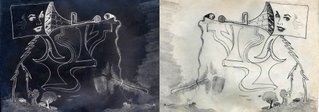
Doodling Fear Away
Since Halloween, I've suffered writer's block. I started working on a new novel a little bit but not in any disciplined kind of way. And now I'm getting glimpses of what I want to write, mainly about the things that have been speaking to me--the new albums by Ludacris, Jerry Lee Lewis and the Who and Dave Marsh's new Springsteen book, In Concert, all wonderful present tense reminders of why I've spent most of my life doing what I do. The urge to write about these things started Wednesday morning, after a good conversation with my Tuesday night class.
We were talking about the graphic novels section of their fiction textbook, and one of them, Josh, pointed out the book's bias against conventional genre comics in favor of more obscure examples from around the world; his brilliant friend Nicki gave the sentiment an amen. (The book's two best known examples from American popular culture were a two page excerpt from Maus and a Lynda Barry piece called "The 2 Questions.")
This led us into a discussion of how and why lit text books (and arts classes in general) are biased against art that is actually a part of most peoples' daily lives. As someone who assigns Charlotte Perkins Gilman's "The Yellow Wallpaper" and whatever Poe I can find every semester as a desperate effort to represent the horror story, I know the bias all too well, and we got it all out on the table and talked about it.
What we really got at are parallel themes in our stories and these observations--for instance, the way the artist is always poised in conflict with society and the way true love always takes place outside of society. However conscious we can agree any of these intentions are, I think we could agree that the social system (and academics--much as it likes to believe it is above the fray--is very much a part of that system, justifying it in the most insidious ways), at least the one we live in, wants to crush anything that clogs its gears.
Being fully human in a system fueled and governed by a fight for wealth and control is a pretty gear clogging desire. But it's the heart of art. The amazing thing about an album like Ludacris's Release Therapy is how it works the system to lodge a wrench right where it can do the most damage, giving so many of us much more room to live and breathe and dance and create than we would have had without it. Just me typing these words is my example for the moment.
I've been down. My daughter lives away from me for the first time in her life, and I miss her. I miss the sense of purpose I can have just being around for her. Everything else in my life can be stuck in neutral, but if I know I'm around for her, it feels all right. And without that, I've lost my axis.
But one thing we share, and my wife and I share, is our love of Luda, and as he says, he's just starting to figure it out. Me too. But what I know it comes down to is that we need each other, and we need to find ways to connect.
He does it beautifully, even with the most unassuming comic rhyme on someone else's record, every time out, and that's what it's all about. On Release Therapy, he's allowed himself to take the second half of the album and bear down on some pretty big statements--a resilient blues for soldiering through social injustice that ends somewhere near the heart of gospel, not so much religious as affirming the dignity of the individual and the need for each other. But from beginning to end, it's Ludacris, which means it's fun, funny and all that much more righteous for striking at such heights.
The other thing that my student Matt and I agreed on was that we liked that little doodley cartoon essay by Lynda Barry. It was as simple as finding a way to make art beyond a need for approval, always--the 2 questions she finds taunting her are "is this any good" and "does this suck"? Though those answers can teach us something sometimes, they aren't why we create, and it's so easy to forget why we create--to feel alive and to make others feel more alive if we're lucky. That's the thing we lose sight of, and then what's the point?
The best part of editing and posting my horror essays was digging through old boxes and finding the doodles and pictures my friends and I used to make for exactly those reasons. I put them up not because I thought they were particularly good but because they seemed to illustrate the impulses behind all of the rest of it. Barry's turned that impulse into her muse, and as different as they are, that's part of that essential quality Ludacris brings to the radio, that sense that he's just having fun in the margins.
Ludacris has built a whole career out of it because he does it so well that the margins have taken centerstage. And again, that's why I'm writing right now--because (thank you, Bruce) I learned more from the margins of my old spirals than I'd ever find in the notes.